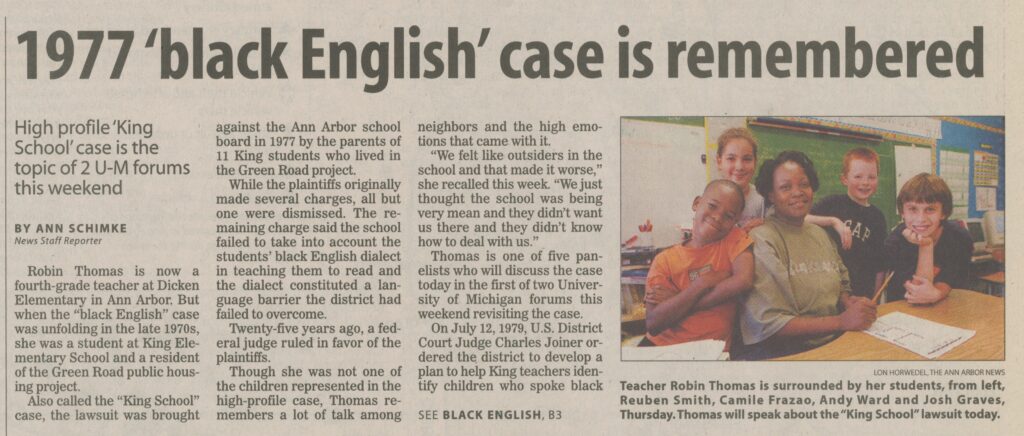4 Striking Similarities of Yahudeyth (Judean, Biblical Hebrew) vs Black English (AAVE, Ebonics)
|
Getting your Trinity Audio player ready...
|
There are Four Striking Similarities of Yahudeyth (Judean, Biblical Hebrew) vs Black English (AAVE, Ebonics)

As I was translating Genesis 49:27, I noticed a striking similarity to Black English (AAVE). You may already know that Black English is a real language with real grammar rules. Racism has caused it to be seen as an erred from of English. Wake up and open your eyes and see the truth, if you don’t know already. Then come back to this information to learn how Black English’s use of verbs is striking similar to Yahudeyth. If you are studying Yahudeyth, Biblical Hebrew (or} Manakahthey (which is one in the same). You may find if you speak Black English, that your overstanding of Yahudeyth will come easy if you translate it using Black English and overstand it in similar terms. Let me explain. I used an advanced AI to help me research other books, websites and publications to help me draw up this information. This AI is GetLiner.com for your reference. I had to first make the connection that there were similarities and it has helped me to articulate it to you here. References will be below this article. Let’s begin
Both Biblical Hebrew and AAVE share a foundational aspect-oriented approach to verbs, allowing for flexible expression that transcends conventional tense usage. Their reliance on context for meaning while prioritizing the quality of actions illustrates their unique grammatical frameworks. – AI Generated
Yahudeyth and Black English both use “to be”, as a flexible expression. The YeD symbol, when used as a prefix to verbs, may communicate present or future tense. Various translations use the context to tell you whether it is future or present, but both are spelled the same. If you don’t realize this, you won’t be able to check translations. Looking at Genesis 49:27.
בנימין זאב יטרף בבקר יאכל – Yahudeyth (Biblical Hebrew)
Benjamin shall ravin as a wolf: in the morning he shall devour the prey. – KJV.
Baneymen wolf he be tearing, in morning he be devouring – Itharey Interpretation
בנימין Baneymen זאב wolf יטרף he be tearing, בבקר in morning יאכל he be devouring – Yahudeyth / Itharey
“Ben be a wolf, always tearin’ stuff up, and come morning, he be straight-up devourin’ it all.” – AAVE / Black English
Which translation of English is correct? The literal translation is correct, but which one was closer to the literal? King James version chose the future tense of “to be”, which was implied, but to be accurate. Benjamin was alive and a full tribe. That verse was speaking in terms of future and present. AAVE translation is easier to understand if you know AAVE. Yahudeyth uses the “implied” to be. The phrase בנימין זאב or Benjamin wolf means “Benjamin is a wolf”. The “is a” is implied and not expressed by reading any symbols. It’s short-handed speech and not required in Yahudeyth. In a way, you can view Yahudeyth as a “poetic language”. Benjamin wolf, he be tearing, he be devouring. You can overstand these words, but it is not Proper American Standard English nor is it proper AAVE, it is more so poetic English.
The grammar structure would be Noun / Adjective / present-future tense with Verb
The following is AI-Generated information from the References below…
1. Aspect versus Tense
Biblical Hebrew primarily relies on aspect rather than tense to convey meanings related to actions. It utilizes two main verb forms: perfect (completed actions) and imperfect (incomplete or ongoing actions). In parallel, AAVE also places a strong emphasis on aspects, employing markers such as “been” and “done” to indicate completed actions, while “be” denotes habitual actions26. Both languages illustrate how actions are perceived in terms of completion and duration rather than adherence to a conventional past, present, or future tense structure.
2. Contextual Dependence
In both Biblical Hebrew and AAVE, understanding the context is crucial to interpreting the meaning of verbal constructions. In Biblical Hebrew, the perfect and imperfect forms do not strictly dictate the time of the action, instead relying heavily on context to convey when the action occurs. Similarly, AAVE uses various markers and contextual cues to signal timing and aspect rather than following a linear tense framework found in Standard English6. This flexibility allows speakers to convey nuanced meanings based on situational context.
3. Grammatical Features
Biblical Hebrew possesses a limited tense system, relying entirely on aspectual forms, which contrasts with languages that utilize extensive tense markers. AAVE is distinguished by its unique grammatical features, such as copula absence (“she talking”) and the habitual “be” for recurrent actions (2. Both languages thus highlight the role of aspect in grammatical constructions, allowing for a diverse expression of time-related concepts without conventional tense markers.
4. Influence of Cultural Context
The roots of Biblical Hebrew and AAVE arise from distinct cultural backgrounds but intersect in their development of unique grammatical systems. Biblical Hebrew is shaped by the historical and religious contexts of ancient Israel, whereas AAVE reflects the cultural experience of African American communities in the United States. Nonetheless, both showcase resilience and adaptability in their linguistic structures, highlighting the interplay between language, culture, and identity15.
What Are the Differences between Modern Hebrew and Biblical/Classical Hebrew? Why Can’t We Use Biblical/Classical Hebrew as It Is for Eve… Quora, 4 Oct. 2024, https://www.quora.com/What-are-the-differences-between-modern-Hebrew-and-biblical-classical-Hebrew-Why-cant-we-use-biblical-classical-Hebrew-as-it-is-for-everyday-use-now.
African American Vernacular English/Verbs/Aspect – Wikibooks, Open Books for an Open World. wikibooks.org, 20 Sept. 2024,
Post. Does Hebrew Have Tense and Aspect? – B-Hebrew: The Biblical Hebrew Forum. biblicalhumanities.org, 4 Oct. 2024, http://bhebrew.biblicalhumanities.org/viewtopic.php?t=930
https://en.wikibooks.org/wiki/African_American_Vernacular_English/Verbs/Aspect.
viewcontent.cgi?article=1469&context=undergrad_rev. (2020). bridgew.edu. https://vc.bridgew.edu/cgi/viewcontent.cgi?article=1469&context=undergrad_rev
African American English: Features & Variants | Vaia. (2024). Vaia. https://www.vaia.com/en-us/explanations/english/global-english/african-american-english/
